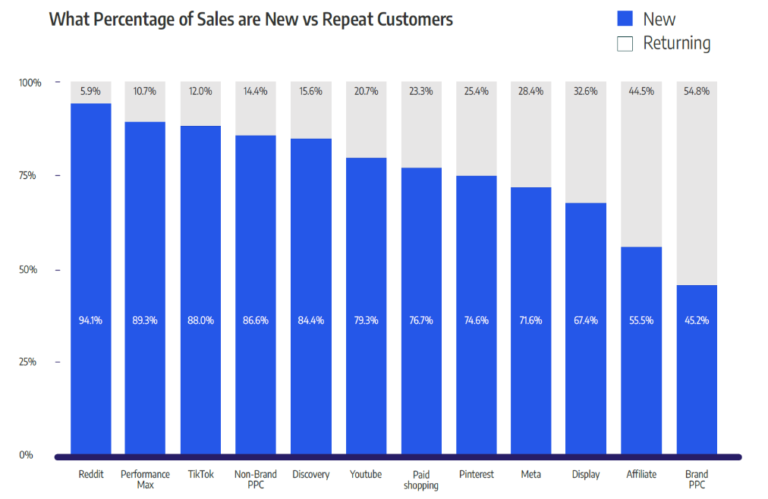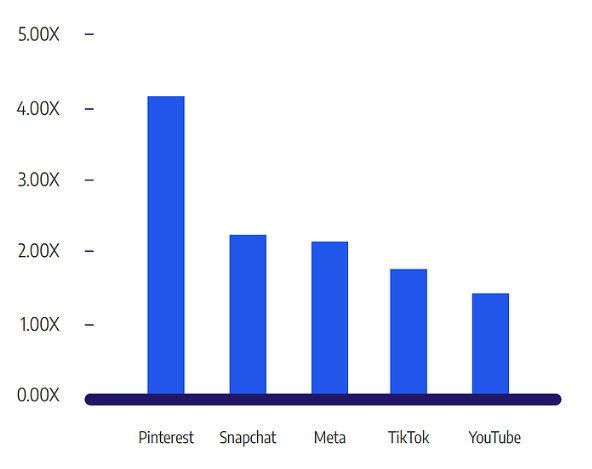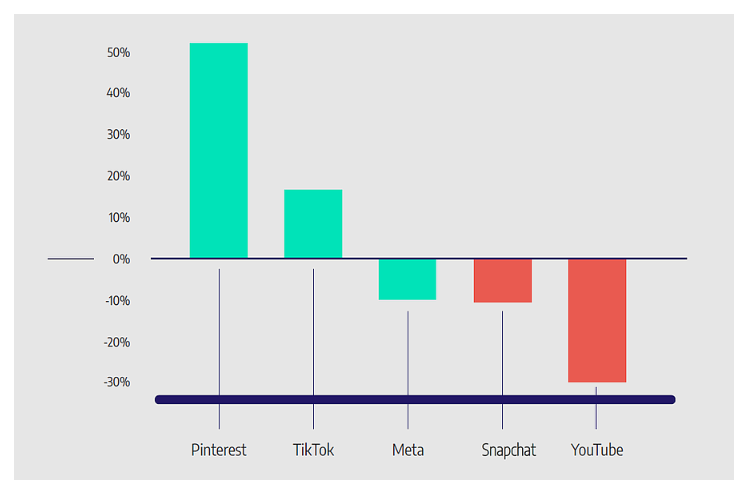30-second summary:
- TikTok is a growing alternative advertising channel with strong returns, but costs are expected to rise as demand increases. Brands should focus on optimization strategies to maximize their ad spend
- Meta is expected to remain a popular choice for ecommerce brands looking to scale sales through advertising
- Google’s Performance Max platform may face increased scrutiny in 2023
- High-performing brands will set themselves apart by investing in top-of-funnel advertising strategies, rather than cutting back on marketing spending
- As the ecommerce industry continues to evolve, it’s important for brands to stay on top of the latest trends and technologies
TikTok: Rising advertising costs on a promising platform
TikTok, known for its short-form video content, has seen significant growth as an alternative advertising channel. Investment in the platform is growing faster than any other digital platform, and returns from the platform are strong, outperforming other growing properties like YouTube.
Brands are allocating more ad budget to TikTok to diversify and boost their ROAS figures, but as demand for ad space increases, costs will also rise. To make the platform yield high returns, optimization strategies, such as creating high-quality, engaging content that resonates with the audience and focusing on creative, will become key.
TikTok ads are a smart choice for ecommerce brands that spend over $50,000 a month on paid media. This is because TikTok is a growing platform with strong returns for advertisers. However, as demand for ad space on TikTok increases, the cost of advertising on the platform will also rise. Therefore, brands will need to have a solid optimization strategy in place to make sure they are getting the most out of their ad spend on (Read more...) platform in order to yield a high return on their investment.
Meta: The go-to advertising platform for scaling ecommerce sales
One trend that is expected to continue in 2023 is the use of Meta as the primary ad platform for driving ecommerce sales at scale. Despite a 12 percent decrease in Meta spend in 2022 due to economic conditions and the introduction of Apple’s iOS 14.5 update, the platform still boasts sophisticated targeting and optimization capabilities and a large reach. As brands focus more on top-of-the-funnel advertising and Meta continues to improve its product, it is expected to remain a popular choice among ecommerce brands.
Performance Max: Under scrutiny for customer acquisition tactics
Google’s Performance Max, a new ad platform, had a strong first year in 2022. However, it may face increased scrutiny in 2023 as research shows that much of the success is due to good optics rather than actual performance.
On top of that, Google blended the reporting of Brand and Generic PPC, leading to inflated ROAS figures, and moved the high-performing Smart Shopping format from Paid Shopping into Performance Max, which has not significantly increased revenue for most brands. Despite these challenges, early results for Performance Max are still positive.
The development of automated delivery formats such as Performance Max is a trend as ad platforms seek to boost performance following privacy-related challenges. The measurement of these formats will be important for attribution platforms and brand-side marketers in 2023.
Pinterest: A leading top-of-funnel advertising channel
Pinterest is expected to cement its status as a top-of-the-funnel ad channel in 2023. While traditionally popular with home furnishings brands, Pinterest is attracting and excelling for brands from other verticals as well.
The visual discovery platform’s user base is highly engaged and actively seeking out new products and ideas, making it a valuable asset for brands looking to get their products in front of potential customers. The platform’s consistently high ROAS makes it a valuable addition to any brand’s ad strategy, and 2023 could be the year it achieves mass adoption.
Brands that excel invest in top-of-funnel advertising strategies
High-performing brands will set themselves apart by investing in top-of-the-funnel advertising. With a difficult market forecast for 2023, it can be tempting for D2C brands to cut back on marketing spending. However, this approach can negatively impact marketing strategies by placing too much emphasis on bottom-of-the-funnel ads, which are easier to measure using platforms like Google Analytics or Meta Ads Manager.
Successful ecommerce brands invest in a balanced marketing funnel, including demand generation and capture, instead of solely focusing on bottom-of-the-funnel ads, which is a short-term solution. To stand out, the best-performing brands take a bold approach and invest across the full funnel, as measuring top-of-the-funnel ads was a popular reason for free trial sign-ups in Q4 2022.
Google Analytics: Businesses will prefer alternative measurement solutions
As the deadline for Universal Analytics approaches, brands will be forced to adopt Google Analytics 4. However, the transition to the new system will not be easy and will result in the loss of year-on-year data. Furthermore, this move will expose the limitations of using Google Analytics as the sole source of truth for marketing measurement.
Ecommerce best practices for 2023
To cut it short, we have put together some best practices for 2023 when it comes to advertising for ecommerce brands. Checking your data can help you figure out what’s working and what needs improvement in your ads.
- Maximize TikTok ad spend by creating engaging, audience-resonant content
- Use Meta as the primary ad platform for driving ecommerce sales at scale, despite the challenges posed by Apple’s iOS 14.5 update
- Be cautious of Google’s Performance Max property, which may face increased scrutiny in 2023 due to inflated ROAS figures
- Consider diversifying ad strategies to include Pinterest, which is a valuable top-of-the-funnel ad channel with a highly engaged user base
- Invest in a balanced marketing funnel, with a focus on both demand generation and capture, to achieve the most successful marketing strategies
- Be prepared for the transition to Google Analytics 4 and the loss of year-on-year data, and consider using independent measurement solutions to validate cross-channel spend
- Diversify advertising beyond Meta and Google to boost ROAS figures and stay competitive in the market
- Be flexible and adaptable to changes and trends in the ecommerce industry and be prepared for a difficult market forecast in 2023
- Take a bold approach to investing in top-of-the-funnel advertising to set yourself apart from competitors and achieve long-term success
In conclusion, the world of ecommerce is evolving rapidly, and staying ahead of the game requires a continuous adaptation to new trends and technologies. As we move deeper into 2023, ecommerce businesses need to prioritize seamless customer experiences, personalized interactions, and a mobile-first approach to design and optimization. Embracing emerging technologies such as augmented reality and chatbots can also help businesses stand out in a crowded market. By adopting these best practices and continually refining their approach, ecommerce businesses can build strong customer relationships, drive conversions, and thrive in the competitive online marketplace.
Jamie Bolton is a ClickZ Advisory Board Member and head of Growth at Fospha, a leading marketing measurement platform for ecommerce.
Subscribe to the ClickZ newsletter for insights on the evolving marketing landscape, performance marketing, customer experience, thought leadership, videos, podcasts, and more.





